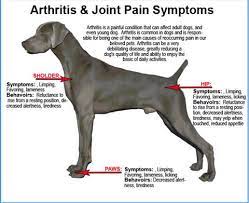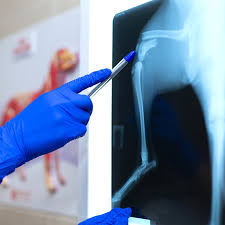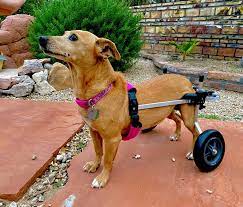Arthritis is a progressive and debilitating condition characterized by inflammation and deterioration of the joints. Arthritis in dogs can affect one or more joints in a dog’s body, leading to pain, stiffness, and reduced mobility. While arthritis is more commonly associated with older dogs, it can also occur in younger animals due to factors such as genetics, trauma, or developmental abnormalities.

Arthritis, also known as degenerative joint disease (DJD), is a common condition affecting dogs of all breeds and ages. In this detailed guide, we will explore the various aspects of arthritis in dogs, including its etiology, pathogenesis, clinical signs, diagnosis, treatment, prevention, and conclusion.
Etiology of Canine Arthritis:
The development of arthritis in dogs can be attributed to various factors, including:
Genetic Predisposition:
Certain breeds are more prone to developing arthritis due to genetic predispositions. Breeds such as Labrador Retrievers, German Shepherds, and Golden Retrievers are known to have a higher incidence of arthritis compared to others.
Trauma and Injury:
Traumatic injuries, such as fractures or ligament tears, can predispose a dog to arthritis later in life. Damage to the joint structures can accelerate the degenerative process and lead to the development of arthritis over time.
Developmental Abnormalities:
Abnormalities in joint development, such as hip dysplasia or elbow dysplasia, can increase the risk of arthritis in affected dogs. These structural abnormalities put additional stress on the joints, contributing to their degeneration.
Pathogenesis of Arthritis in Dogs:
The pathogenesis of arthritis involves a complex interplay of inflammatory mediators, cartilage degradation, and joint remodeling. Chronic inflammation within the joint leads to the release of enzymes that break down the cartilage, resulting in loss of joint cushioning and increased friction between bones. Over time, this process leads to the formation of osteophytes (bone spurs) and further joint damage.
Clinical Signs of Canine Arthritis:
Recognizing the clinical signs of arthritis is essential for early detection and intervention. Common symptoms of arthritis in dogs include:
- Lameness: Dogs with arthritis may exhibit a limp or favoring of one limb.
- Stiffness: Difficulty getting up, especially after rest, is a hallmark sign of arthritis.
- Decreased Activity: Dogs may become less active or reluctant to engage in physical activities they once enjoyed.

- Joint Swelling: Inflammation of the affected joints can result in swelling and discomfort.
- Pain or Discomfort: Dogs may vocalize or show signs of pain when moving or being touched around affected joints.
Diagnosis of Arthritis in Dogs:
Diagnosing arthritis in dogs typically involves a combination of clinical evaluation, radiographic imaging, and laboratory tests. Veterinarians may perform the following diagnostic procedures:
Physical Examination;
A thorough physical examination allows veterinarians to assess joint mobility, detect swelling or inflammation, and evaluate the overall condition of the dog.
Radiographic Imaging:
X-rays are commonly used to visualize changes in the joint structure, including cartilage loss, bone remodeling, and the presence of osteophytes.

Joint Aspiration:
Aspiration of joint fluid may be performed to evaluate for signs of inflammation, infection, or other underlying joint conditions.
- To know about Cherry eye in dogs CLICK HERE
Treatment Options for Canine Arthritis:
Managing arthritis in dogs aims to alleviate pain, improve joint function, and slow the progression of the disease. Treatment options may include:
Medications:
Nonsteroidal anti-inflammatory drugs (NSAIDs) are often prescribed to reduce pain and inflammation associated with arthritis. Other medications, such as corticosteroids or joint supplements, may also be recommended.
Weight Management:
Maintaining a healthy body weight is crucial for dogs with arthritis, as excess weight puts added stress on the joints. A balanced diet and regular exercise can help manage weight and improve overall joint health.
Physical Therapy:
Physical therapy techniques, such as massage, stretching exercises, and hydrotherapy, can help improve joint mobility, strengthen supporting muscles, and reduce pain in arthritic dogs.

Surgical Intervention:
In severe cases of arthritis, surgical procedures such as joint replacement or arthroscopic surgery may be considered to alleviate pain and improve joint function.
Prevention of Arthritis in Dogs:
While some risk factors for arthritis, such as genetics, cannot be controlled, there are steps pet owners can take to reduce the likelihood of their dog developing the condition:
- Maintain a Healthy Weight: Avoiding obesity and providing regular exercise can help prevent excessive strain on the joints.

- Regular Veterinary Care: Routine check-ups and early intervention can help identify and address joint issues before they progress to arthritis.
- Joint-Friendly Nutrition: Feeding a balanced diet rich in omega-3 fatty acids and joint-supporting nutrients can promote joint health and reduce inflammation.
Conclusion:
Arthritis is a prevalent and debilitating condition affecting dogs of all ages. By understanding the causes, clinical signs, diagnosis, and treatment options for arthritis, pet owners can take proactive steps to manage the condition and improve their dog’s quality of life. With early intervention, appropriate medical management, and supportive care, dogs with arthritis can continue to lead happy, active lives.
Frequently Asked Questions:
- How can I tell if my dog is in pain from arthritis?
- Look for signs such as limping, stiffness, reluctance to move, and changes in behavior. Your veterinarian can perform a thorough examination to assess your dog’s pain level and recommend appropriate treatment.
- Can arthritis be cured in dogs?
- While arthritis cannot be cured, its progression can be managed through various treatment modalities to improve comfort and quality of life.
- What are the side effects of arthritis medications for dogs?
- Common side effects of arthritis medications include gastrointestinal upset, liver or kidney toxicity, and allergic reactions. It’s essential to follow your veterinarian’s recommendations and monitor your dog closely for any adverse effects.
- Is surgery necessary for all dogs with arthritis?
- Surgery is typically reserved for cases where conservative treatments have been unsuccessful or when joint damage is severe. Your veterinarian will evaluate your dog’s condition and discuss the most appropriate treatment options.
- How can I prevent arthritis in my younger dog?
- Preventative measures such as maintaining a healthy weight, providing regular exercise, feeding a balanced diet, and attending routine veterinary check-ups can help reduce the risk of arthritis development in younger dogs. Early detection and intervention for joint abnormalities can also be beneficial.

